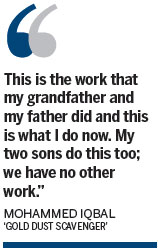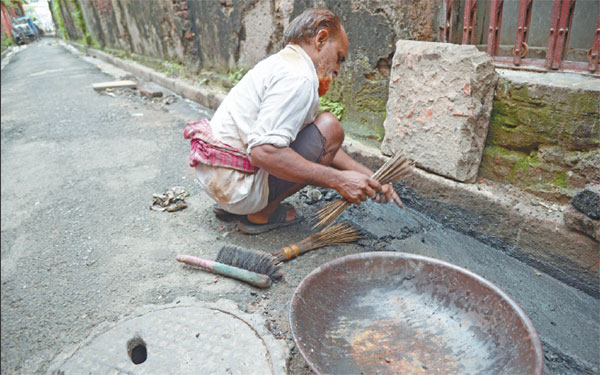Gold panners reap rewards at market
Jewelry makers say scavengers help keep costs of production low
As 40-year-old Mohammed Iqbal sifts through sludge in the back alleys of Kolkata's jewelry market for gold dust, his weathered face brightens slightly at the recent increase in work.
For generations, the city's group of "newaras" - gold dust scavengers - have been scratching a living by panning for fine particles swept from the 2,000-odd jewelry workshops operating in the alleys.
Iqbal estimates he normally earns just 150 to 200 rupees ($2.40 to $3.20) a day from selling flecks of the precious metal that he painstakingly finds on the ground and in the drains of the grimy alleys.
But the onset of India's raucous festival season, especially the biggest Hindu celebration of Diwali on Thursday, brings a relative bonanza for Iqbal, with his income more than doubling.
"There is a lot of work during Durga Puja and Diwali. We make more money then," Iqbal said as he hunched over his pans filled with thick, black muck early one morning.
"We never got an education. This is the work that my grandfather and my father did and this is what I do now. My two sons do this too; we have no other work," he said of his sons, aged 18 and 16.
Over the several days of Diwali, known as the festival of lights, middle-class families throng Kolkata's Bowbazar and other markets throughout the country to buy gold jewelry.

The Hindu goddess of wealth is worshipped during Diwali, which is considered an auspicious time to buy gold, especially as gifts for family members.
The festival coincides with India's wedding season, which runs from October to February, with gold a crucial part of a bride's dowry.
In the lead-up, jewelry workshops, including those in the former British colonial capital, go into overdrive, with hundreds of craftsmen spending hours at their benches to produce intricate necklaces, bracelets and earrings on sale in showrooms.
Yellow particles are swept outside, while some are washed into drains, surfacing in the alleys where the newaras sift through the sludge to find them.
Prayers and gold
Jewelry traders predict a prosperous Diwali this year, with world and local gold prices lower, making resulting ornaments more affordable.
Bachhraj Bamalwa, director of the All India Gems and Jewelry Trade Federation, said: "We are expecting a very good Diwali compared to previous years.
"The mood is upbeat and there have been incremental increases in sales of gold jewelry."
India is the world's biggest buyer of gold alongside China, and imports normally jump during the festival season, further widening the trade deficit.
India's central bank has lifted restrictions on importing gold, allowing more private agencies to bring in shipments.
Bamalwa said this has pushed down the local price of the metal this year, lifting consumer spirits. In New Delhi, shoppers crowded the capital's old quarter searching for gold and other bargains for Diwali.
Housewife Aswani Puja said: "It doesn't really matter that the price keeps going up and down. Buying gold is a tradition, it's a custom, you cannot offer prayers without also offering some gold."
Some jewelry manufacturers in Kolkata are grateful for the newaras, who help keep production costs down for the industry, which was established in the 1800s and employs about 20,000 people.
Nabin Kumar Chanbar, whose shop opened in 1883, said: "If they are not doing this then we have to buy gold, and the only gold source is Western countries.
"They are very helpful because the gold waste is returned to the industry."
|
An Indian "newara" (gold dust scavenger) sweeps an alleyway drain near jewelry workshops in search of flecks of the precious metal in Kolkata. Mohammed Iqbal, 40, estimates he usually makes 150 to 200 rupees ($2.40 to $3.20) a day. Dibyangshu Sarkar / Agence Rancefresse |
(China Daily 10/23/2014 page10)















